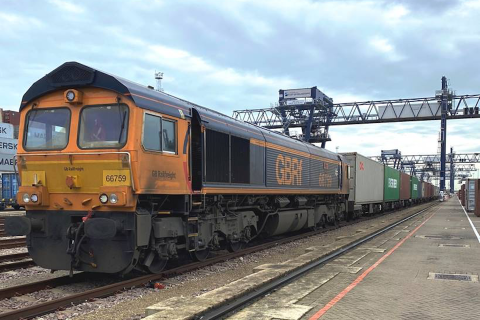Extinguishing test failed at Dutch emplacement Waalhaven

In the Dutch emplacement of Waalhaven South, a temporary solution of the fire-extinguishing system for freight wagons with dangerous goods was tested, but without success.The test was terminated prematurely because the coupling of one of the extinguishing hoses disconnected.
The test was carried out by infrastructure manager ProRail last Friday, 1 November. The construction of the temporary water system had taken almost three weeks, following the stop of shunting with hazardous substances at the Waalhaven yard in the Port of Rotterdam. An investigation had made clear that the fire extinguishing water facilities did not meet the existing safety requirements.
Failure
The new, temporary construction consists of a three-kilometer fire hose connected to a water basin near the yard. The hose consists of several parts that are connected to each other. One of the couplings disengaged during the test.
As a result, ProRail had to abort the test prematurely. “In the coming days the cause of the disconnection will be investigated, and we will decide what measures we should take to prevent repetition”, ProRail reports in a press release. It is not known when the test can be carried out again, or when shunting of dangerous goods can be resumed.
Temporary stop
Shunting freight trains with hazardous substances at Waalhaven-Zuid came to a halt on 13 September. An exercise proved that that there was not enough extinguishing water, that the water did not reach far enough during firefighting and that it took too long for the fire brigade to extinguish the fire.
Due to these factors, ProRail firefighters and incident fighters would have to come too close to a possible firebox to extinguish it. In addition to a temporary solution, ProRail also says it is working on a permanent solution to improve the extinguishing capacity. The infra manager wants to build wells for this, but the work is not expected to be completed until the beginning of next year.
Response
There is a lot of frustration within the rail freight sector about the shutdown of activities with hazardous substances at Waalhaven-Zuid. In the meantime, these trains have not been used for almost two months. The shunting activities have largely been relocated to the Kijfhoek yard, but this requires extra manpower and longer lead times. For example, changing the locomotives takes an hour in Waalhaven, but according to the carriers at Kijfhoek, this process takes a few hours there.
Waalhaven-Zuid is a crucial shunting area for the transport of containers, tank containers, trailers and swap bodies that enter and leave the port and travel further to destinations such as Venlo, Tilburg, Coevorden and Duisburg, but also further to Poznan, Milan, Vienna, Budapest and China.
You just read one of our premium articles free of charge
Want full access? Take advantage of our exclusive offer






